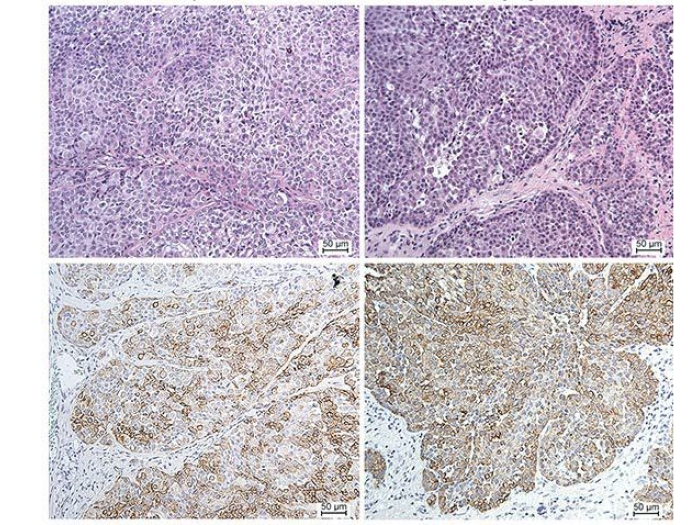DNA and RNA sequencing of 500 patients with solid tumors revealed potential treatment targets and opened the door to a deeper understanding of metastatic cancer.
1:00 PM
Author |

The average metastatic cancer has more genetic mutations than are seen in early stage tumors, a new study finds.
MORE FROM THE LAB: Subscribe to our weekly newsletter
What that means: To make precision medicine a reality in cancer care, you need a real-time, comprehensive approach that looks at the metastatic tumors and sequences to a level of detail beyond most commercial tests.
In one of the largest and most comprehensive efforts to examine the genetic and molecular landscape of advanced cancer, researchers at the University of Michigan Comprehensive Cancer Center sequenced the DNA and RNA of 500 patients with metastatic cancer. The results are published in Nature.
Three things make this analysis unique:
-
Researchers obtained fresh biopsies for most patients, extracting samples from the metastatic tumors, rather than the primary tumor.
-
They sequenced both DNA and RNA.
-
They compared the cancerous tissue with the patient's normal DNA.
"This is a more comprehensive approach than most commercially available clinical sequencing programs. Our results suggest value on several levels to this more detailed approach," says senior study author Arul Chinnaiyan, M.D., Ph.D., director of the Michigan Center for Translational Pathology.
The data reflect the first 500 patients with solid tumors to enroll in the Michigan Oncology Sequencing Program, a research protocol that began in 2010, sequencing the DNA and RNA of metastatic cancers and normal tissue to identify alterations that could help drive treatment. The program includes a precision medicine tumor board in which experts discuss each case. Mi-ONCOSEQ was among the first comprehensive clinical sequencing programs offered for cancer patients.
The patients represented in the Nature paper spanned more than 30 types of cancer, with metastases in 22 organs. It included only adults with solid tumors, though Mi-ONCOSEQ is available to patients with blood cancers and to children.
Biopsy the metastasis, not archived tumor
Researchers found a significant increase in the number and type of mutations between patients' metastatic cancer and primary cancer. Nearly every case of metastatic cancer had more mutations, they found. This likely reflects that metastatic cancers are more aggressive: They've had more time to develop additional mutations, and treatments designed to kill the cancer have caused more mutations.
SEE ALSO: Precision Medicine Test for Breast Cancer Helps Guide Chemotherapy Decisions
"Our findings emphasize the importance of getting a fresh biopsy of the metastatic tumor," Chinnaiyan says. "Tumors are evolving as part of metastasis and under therapy. We need to biopsy the metastatic tumors and then suggest therapies, rather than using archival tissue from the primary tumor."
We need to biopsy the metastatic tumors and then suggest therapies, rather than using archival tissue from the primary tumor.Arul Chinnaiyan, M.D., Ph.D.
RNA sequencing reveals more targets
The other key component is sequencing the RNA as well as the DNA. This more extensive approach revealed a host of molecular factors that play a role in the tumor microenvironment, fostering and allowing the cancer to continue to grow, spread or evade treatment.
Generally, most clinical sequencing efforts focus on DNA sequencing only. While DNA sequencing reveals genetic alterations involved in metastatic cancer, researchers found RNA sequencing shed light on the underlying mechanisms that either turn on cancer-causing genes or turn off the genes meant to stop cancer. Their findings could help identify potential targets for treatment.
In addition, by looking at RNA, researchers could examine the immune cells in the tumor microenvironment, which offered clues to why immunotherapy might work for some patients but not for others.
"Understanding the immune microenvironment — the types of cells infiltrating the tumor and what they are expressing — is important. It gives us a picture of the immunophenotype. Our hypothesis is that we could use this to help determine who is likely to respond to immunotherapy," Chinnaiyan says, noting that more research is needed in this area.
Another key finding is that metastatic tumors exhibited one of two mutually exclusive signatures. One version was highly proliferative, meaning it multiplied aggressively. In the other version, cells lost their differentiation, a state called epithelial-mesenchymal transition.
SEE ALSO: How Genomic Sequencing May Be Widening Racial Disparities in Cancer Care
"Not all metastases are the same. Different pathways are driving them to be quite different — highly proliferative versus those that are differentiating more. This mutually exclusive aspect was a striking finding that could guide us in developing new types of therapies," Chinnaiyan says.
Inherited mutations uncovered
Another striking finding was that 12 percent of the metastatic cancer patients harbored an inherited mutation. This is roughly quadruple what might be expected among all cancer patients. These mutations were identified by comparing the tumor DNA with the normal DNA.
About three-quarters of these mutations were related to the process of DNA repair, which several existing therapies are designed to target.
"There is a high percentage of inherited mutations in metastatic cancer. Once these mutations are identified, it's possible others in the family may also carry that gene and be at higher risk of cancer," Chinnaiyan says.
Family members might seek genetic counseling or additional screening, if appropriate. Patients in Mi-ONCOSEQ received genetic counseling, which was also extended to their families in cases of inherited mutation.
The researchers are analyzing patient outcomes from this initial group. Preliminary data presented this year at the American Society of Clinical Oncology annual meeting suggested that three-quarters of patients whose tumors were sequenced had an "actionable mutation," meaning treatments exist to target that aberration. Nearly 2,300 patients have enrolled in Mi-ONCOSEQ to date.
Mi-ONCOSEQ is available for patients with metastatic cancer. For information, call the U-M Cancer AnswerLine at 800-865-1125

Explore a variety of health care news & stories by visiting the Health Lab home page for more articles.

Department of Communication at Michigan Medicine
Want top health & research news weekly? Sign up for Health Lab’s newsletters today!





